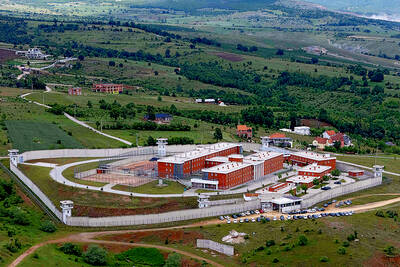India is close to becoming the world’s sixth country to put a nuclear-armed submarine into operation, a move that would give it a leg up on neighboring Pakistan and intensify a race for more underwater weapons in Asia.
The 6,000-tonne Arihant, developed over the past three decades under a secret government program, is completing its final trials in the Bay of Bengal, according to a senior Indian Navy officer who declined to be identified, because he was not authorized to speak about the program.
The vessel is to be operated by the navy, but under the direct control of the Indian Nuclear Command Authority headed by Indian Prime Minister Narendra Modi.
The deployment would complete India’s nuclear triad, allowing it to deliver atomic weapons from land, sea and air. Only the US and Russia are considered full-fledged nuclear triad powers, with China and India’s capabilities still largely untested.
India’s move might prod China to bolster its undersea arsenal and assist nuclear-armed allies Pakistan and North Korea in developing similar technologies. That risks potentially more dangerous altercations in Asia’s waters, where territorial disputes have contributed to a region-wide naval buildup.
On Nov. 25 last year, the Arihant reportedly test-fired a training missile, the Indo-Asian News Service reported, citing officials it did not identify.
Indian Ministry of Defence spokesman Nitin Wakankar did not respond to questions seeking comment on the submarine’s deployment or the test.
Both India and China espouse a no-first-use policy on nuclear arms. Their efforts to arm submarines with atomic weapons are theoretically aimed at preventing the outbreak of war by discouraging enemies from attacking.
Ballistic-missile submarines are widely considered to have played a deterrent role in the Cold War.
The US, UK, France, Russia and most recently China have nuclear-armed submarines in operation. The 110m-long Arihant would be harder to detect than India’s nuclear weapons on land and air, giving it a “second-strike” capability to retaliate against an enemy who managed to destroy the rest of the arsenal.
China began combat patrols of an armed nuclear-powered submarine last year, the Washington Times reported in December last year, citing the US Strategic Command and Defense Intelligence Agency. While China has not made a formal announcement, and US officials have not confirmed that nuclear-tipped JL-2 missiles were on board the submarines conducting patrols, they have no evidence that the vessels were not armed.
“Given China’s known capabilities and their efforts to develop a sea-based deterrent, in absence of indicators to the contrary, it is prudent to assume that patrols are occurring,” US Navy Captain Pamela Kunze, a spokeswoman for the Strategic Command, told the Washington Times.
Even so, neither India nor China have reached the technical prowess to give them a credible nuclear deterrent. Their submarines are loud and easily detected, making them an unlikely second-strike asset, the Lowy Institute for International Policy said in a report in September last year.
Potentially more worrisome is that neither Pakistan nor North Korea subscribe to a no-first-use policy, and there are signs that both nations are pursuing cruder methods of deploying nukes at sea.
Last year, Pakistan finalized a deal to buy eight Chinese conventional submarines, raising concerns that they could be equipped with riskier nuclear-tipped cruise missiles. North Korea also claimed to have tested a submarine-launched missile and said that it had developed technology to mount a nuclear warhead on a missile.
“There will likely be a long phase of initial instability, as China and India start deploying nuclear missiles on submarines,” the Lowy report said. “Chinese and Indian nuclear-armed submarines — along with possible Pakistani and North Korean units — may remain detectable by adversaries, making their activities unpredictable in times of crisis. Moreover, these supposedly stabilizing new forces may worsen wider maritime tensions.”
China boasts at least 62 submarines, including four capable of firing nuclear ballistic missiles, according to the Pentagon. China’s construction of artificial islands, radar facilities and runways in the South China Sea might be aimed at using the territory as a base for its nuclear ballistic missile submarine fleet, the Lowy report said.
The **Arihant** is to be India’s first nuclear-powered and armed vessel that has been designed and built at home. The country is believed to have begun work on it in the 1980s with help from the Soviet Union, particularly on the vessel’s miniaturized reactors.
In 2012, India also leased a nuclear-powered submarine from Russia under a 10-year, US$1 billion contract. The two countries are negotiating a deal to lease another one, Indian-based newspaper the **Pioneer** reported this month, citing Russian Ambassador to India Alexander Kadakin.
Despite numerous setbacks, India is making progress on developing the weapons to arm the undersea vessels. In 2013, India test-fired an underwater ballistic missile with a range of 750km, the **Hindu** newspaper reported, citing an unidentified scientific adviser to the defense minister.
In September last year, the Indian Defense Research and Development Organization publicly acknowledged having readied a submarine-launched ballistic missile with a 3,500km range at an awards event for military scientists attended by Modi.
India needs to show the world it can capably and effectively operate the nuclear-armed submarine, IHS Jane’s Asia-Pacific defense industry analyst Jon Grevatt said.
The “important milestone” is part of a bigger strategy to ensure its security, he said.
“The **Arihant** is a stepping stone for India,” he said. “I don’t think it will alter the balance of power in the region unless India has a fleet of four or five such submarines.”

Packed crowds in India celebrating their cricket team’s victory ended in a deadly stampede on Wednesday, with 11 mainly young fans crushed to death, the local state’s chief minister said. Joyous cricket fans had come out to celebrate and welcome home their heroes, Royal Challengers Bengaluru, after they beat Punjab Kings in a roller-coaster Indian Premier League (IPL) cricket final on Tuesday night. However, the euphoria of the vast crowds in the southern tech city of Bengaluru ended in disaster, with Indian Prime Minister Narendra calling it “absolutely heartrending.” Karnataka Chief Minister Siddaramaiah said most of the deceased are young, with 11 dead

By 2027, Denmark would relocate its foreign convicts to a prison in Kosovo under a 200-million-euro (US$228.6 million) agreement that has raised concerns among non-governmental organizations (NGOs) and residents, but which could serve as a model for the rest of the EU. The agreement, reached in 2022 and ratified by Kosovar lawmakers last year, provides for the reception of up to 300 foreign prisoners sentenced in Denmark. They must not have been convicted of terrorism or war crimes, or have a mental condition or terminal disease. Once their sentence is completed in Kosovan, they would be deported to their home country. In

Brazil, the world’s largest Roman Catholic country, saw its Catholic population decline further in 2022, while evangelical Christians and those with no religion continued to rise, census data released on Friday by the Brazilian Institute of Geography and Statistics (IBGE) showed. The census indicated that Brazil had 100.2 million Roman Catholics in 2022, accounting for 56.7 percent of the population, down from 65.1 percent or 105.4 million recorded in the 2010 census. Meanwhile, the share of evangelical Christians rose to 26.9 percent last year, up from 21.6 percent in 2010, adding 12 million followers to reach 47.4 million — the highest figure

LOST CONTACT: The mission carried payloads from Japan, the US and Taiwan’s National Central University, including a deep space radiation probe, ispace said Japanese company ispace said its uncrewed moon lander likely crashed onto the moon’s surface during its lunar touchdown attempt yesterday, marking another failure two years after its unsuccessful inaugural mission. Tokyo-based ispace had hoped to join US firms Intuitive Machines and Firefly Aerospace as companies that have accomplished commercial landings amid a global race for the moon, which includes state-run missions from China and India. A successful mission would have made ispace the first company outside the US to achieve a moon landing. Resilience, ispace’s second lunar lander, could not decelerate fast enough as it approached the moon, and the company has